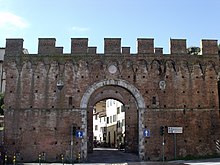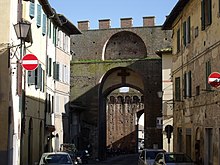Porta Ovile
The Porta Ovile is a city gate in Siena and part of the city walls of Siena .
location
The city gate Porta Ovile is located in the north-eastern part of Siena at the end of Via Vallerozzi . The street that continues after the city gate is called Via Simone Martini ; Via Domenico Beccafumi goes north from here. The street leading south and to Porta Pispini is Via Baldassare Peruzzi . The section along Via Peruzzi to Porta Pispini is the longest with a length of 1350 meters without any further city gates. The city gate is located in the third third of the city, Terzo di Camollia, in the Contrada Bruco (caterpillar) and borders directly on that of the she- wolf (Lupa). It is located in the ring of the city wall between the no longer existing gate Porta San Lorenzo (also Barriera di San Lorenzo , now called Le Lupe ) and Porta Pispini.
construction
The city gate is a chamber gate with an outer antechamber that was added later. The main gate has a device for a portcullis (Saracinesca). In addition to its military function, the gate also served customs (Dazio). The customs house with weighing station can only be partially recognized today. The brick and bridge-like path to the antechamber towered above street level at that time, and the area in front of the antechamber was not filled up until the 19th century. All that remains of the original construction outside the gate are the stairs that lead to the Fonte d'Ovile fountain . The wooden cross on the inside of the main gate was removed in 1930 and is now in the Contradenmuseum of the Contrada Bruco . The wooden cross that can be seen today was made by the craftsmen of the Contrada and placed in the previous place in March 2001. Furthermore, on the inside left side of the main gate is the fresco Madonna, il Bambino fra Sant'Ansano, San Bernardino e angeli by Sano di Pietro , one of the oldest frescoes on Siena's city walls.
history
The name Ovile (also Uvile ) was first documented in 1093. As Borgo d'Ovile the areas have been right and left sides of today's street Via dei Rossi (then Via del Borgo d'Ovile ), respectively. Today the street divides the Contraden Bruco (left or northern part) and Giraffa (right side seen from the city center). The northeastern lowlands were named Pian d'Ovile (also Piano d'Ovile ). The Borgo d'Ovile was included in the fortifications as part of the first expansion of the medieval city walls , the Pian d'Ovile followed with the second expansion. The Porta Ovile was built between the new city gates Porta San Lorenzo (north) and Porta dei Frati Minori (south) as part of this city wall expansion . To this end, the city of Siena acquired properties from 1,220. The main reason for the position of the gate was the access to the Fonte d'Ovile fountain, built in 1228 and enlarged in 1262 , which is still only a few meters outside the city walls and the city gate, and access to the Borgo Ravacciano (is still outside the City walls). In the 15th century it was also used as a route over today's Via Simone Martini to the Basilica dell'Osservanza . After the military conflict with Florence , it was decided to rebuild the fountain within the city walls. A commission that included Duccio di Buoninsegna and Giovanni Pisano first developed plans for this in 1295. The new fountain was built at the end of the 13th century in Gothic style by Sozzo di Rustichino and Camaino di Crescentino, the father of Tino di Camaino , as Porta Nuova dal piano della fonte Ovile in today's Contrada Lupa in the immediate vicinity of the city gate and was in 1303 already completed.
The construction of the gate began around 1230. In the household books of the city of Siena, called Biccherna , the city gate appears in 1247 and 1250 under the name Porta di Vallerozzi , and in 1251 under its current name. In 1258, due to the conflicts that led to the Battle of Montaperti (September 1260) , the gate was closed with wooden crates. In 1416 the city walls were expanded in the course of the fifth city wall extension and now included the Basilica di San Francesco . The new section of the city wall has since extended from Porta Ovile to Porta Pispini. The front wall or antechamber probably dates back to 1471. In the conflict with Florence, which led to the defeat and capture of Siena through the siege from 1554–1555, the city gate remained largely undamaged despite the bombing of the Fiorentine troops from Ravacciano, but was damaged in early November Walled up in 1554. Major changes outside the gate were made in 1861 when the streets adjacent to the city walls to Porta Pispini (Via Baldassare Peruzzi) and the Barriera di San Lorenzo (Via Domenico Beccafumi) were built. The bridge-like access route to the city gate disappeared in 1930 when the gate was restored.
traffic
The Porta Ovile is one of the few city gates in Siena that is outside the restricted traffic zone (ZTL - Zone a traffico limitato) and through which passage is permitted. There is also a traffic junction for local public transport just outside the city gate.
literature
- Ettore Pellegrini: Fortificare con arte. Mura, porte e fortezze di Siena nella Storia. Betti Editrice, Siena 2012, ISBN 978-88-7576-228-5
- Emanuele Repetti: Ovile (Porta) o Uvile di Siena . (PDF) In: Dizionario Geografico Fisico Storico della Toscana. (1833–1846) (Italian)
- Piero Torriti: Tutta Siena. Contrada per Contrada. Edizioni Bonechi, Florence 2004, ISBN 88-7204-456-1
- Touring Club Italiano : Toscana. Milan 2003, ISBN 978-88-365-2767-0 , p. 573
Web links
Individual evidence
- ^ Stefano Maggi: Il piano regolatore di Siena del 1956. All origini della città fuori le mura. Protagon Editori, Siena 2011, ISBN 978-88-8024-309-0 , p. 53
- ↑ a b c d e f g Piero Torriti: Tutta Siena. Contrada per Contrada.
- ↑ a b c d e f Ettore Pellegrini: Fortificare con arte. Mura, porte e fortezze di Siena nella Storia.
- ↑ a b c Emanuele Repetti: OVILE (PORTA) o UVILE DI SIENA.
- ^ A b Touring Club Italiano: Toscana.
- ↑ Enciclopedie on line for Tino di Camaino , accessed on January 20, 2014 (ital.)
- ^ Fausto Landi: Gli ultimi anni della Repubblica di Siena 1525–1555. Edizioni Cantagalli, Siena 1994, p. 201
Coordinates: 43 ° 19 ′ 25.2 ″ N , 11 ° 19 ′ 58.4 ″ E

